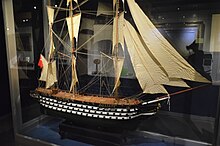Ottoman ship Mahmudiye
 Mahmudiye in Istanbul
| |
| History | |
|---|---|
| Name | Mahmudiye |
| Owner | Ottoman Navy |
| Builder | Imperial Arsenal , Constantinople |
| Launched | 30 November 1828.[1] |
| Decommissioned | 1878 |
| Honours and awards | Title of Gazi awarded to the ship for her role during the Siege of Sevastopol (1854–1855) |
| Fate | Broken up |
| General characteristics | |
| Displacement | unknown |
| Length | 76.15 m (249.8 ft) |
| Beam | 21.22 m (69.6 ft) |
| Armament | 128 guns on three decks |
Mahmudiye was a ship of the line of the Ottoman Navy. It was a three-masted three-decked 128-gunned sailing ship, which could perhaps be considered to be one of the few completed heavy first-rate battleships in the world.[2] Mahmudiye, with a roaring lion as the ship's figurehead, was intended to serve to reconstitute the morale of the nation after the loss of the fleet at the Battle of Navarino in 1827. The flagship was for many years the largest warship in the world.[3]
Characteristics
The 201 × 56
It was a 120-gun ship of the line, with guns ranging from 3-pounders to massive 500-pounders that fired stone shot.[2] These guns were mounted on the broadside across three decks. At the time of her completion, it was the largest sailing ship ever built.[3]
Service history
It was constructed by the naval architect Mehmet Kalfa and the naval engineer Mehmet Efendi on the order of
Egyptian-Ottoman Wars

At the outbreak of the
After the death of Sultan
Later career

Mahmudiye participated in the
With the introduction of steam power at the end of the 1840s, the conversion of the pure sail-driven ship into a steamer was considered. On inspecting the hull in Britain in the late 1850s, however, it was discovered to be badly rotted, and not worth reconstructing. The machinery that had been allocated to Mahmudiye was instead installed on the frigate Mubir-i Sürur.[9]
During the Russo-Turkish War of 1877–1878, Mahmudiye was placed into service as a troop transport, as the government lacked sufficient transport ships. The ship's great size made her an effective transport, owing to her ability to carry a large number of troops. On 27 December, four Russian torpedo boats attacked Mahmudiye and the ironclad Asar-i Tevfik while they were moored in Batumi, but all of their attacks missed.[10]
Notes
- ^ "Constantinople, Dec. 11". The Times. No. 13806. London. 19 January 1829. col B, p. 4.
- ^ a b c Daly, p. 69
- ^ a b Sondhaus, p. 17
- foot, hence the wrongly converted dimensions of "201 × 56 ft" or "62 × 17 m" in some sources.
- ^ Langensiepen & Güleryüz, p. 3
- ^ Langensiepen & Güleryüz, pp. 3–4
- ^ Ufford, p. 71
- ^ Langensiepen & Güleryüz, p. 4
- ^ Langensiepen & Güleryüz, p. 2
- ^ Langensiepen & Güleryüz, p. 6
References
- Daly, John C. K. (1991). Russian Seapower and 'the Eastern Question' 1827–41. Annapolis: Naval Institute Press. ISBN 1557507260.
- Langensiepen, Bernd & Güleryüz, Ahmet (1995). The Ottoman Steam Navy 1828–1923. London: Conway Maritime Press. ISBN 978-0-85177-610-1.
- Sondhaus, Lawrence (2001). Naval Warfare, 1815–1914. London: Routledge. ISBN 978-0-415-21478-0.
- Ufford, Letitia W. (30 July 2007). The Pasha: How Mehemet Ali Defied the West, 1839–1841. Jefferson: McFarland. ISBN 978-0786428939.
Further reading
- Bulgurcuoğlu, Hacer. Efsane Gemi Mahmudiye Kalyonu. Deniz Kuvvetleri.
- Bulgurcuoğlu, Hacer (2007). "Türk Deniz Harp Tarihinde İz Bırakan Gemiler, Olaylar ve Şahıslar". Piri Reis Araştırma Merkezi Yayını (8). İstanbul: Deniz Basımevi. ISBN 978-975-409-452-7.
- İşcan, Nejat (2000). Fotoğraflarla Mahmudiye. İşcan Yayınları. p. 35. ISBN 978-975-96495-7-9.
External links
 Media related to Mahmudiye (ship, 1829) at Wikimedia Commons
Media related to Mahmudiye (ship, 1829) at Wikimedia Commons- https://www.tdefenceagency.com/mahmudiye-efsanesi-doguyor/ - History and images (Turkish)
